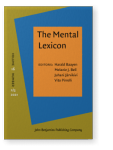Vol. 16:2/3 (2021) ► pp.397–421
Learning beyond words
Morphology and the encoding of hierarchical categories
Learning multimorphemic words involves the simultaneous learning of two hierarchically organized categories. In such words, sub-lexical units usually encode superordinate categories, whereas whole words encode exemplars of these categories. Complex, non-linear word structure is common in Semitic languages and can be used to probe the learning of multiple form-meaning associations. The aim of this study was to investigate how well Hebrew-speaking adults learn the dual form-meaning relationships that reflect different categorical levels following a few exposures to novel Hebrew-like words. Twenty-four native Hebrew-speakers were exposed to novel words through an interactive video story. Following a few exposures to the words, the learning of the exemplars was tested in a three-alternative-forced-choice identification test. The learning of the sub-lexical morphemes and the categories they encode were tested in generalization tests. The results show that a few exposures to novel, morphologically and conceptually complex words are sufficient to allow unsupervised simultaneous learning of two hierarchical categories even though the superordinate was not explicitly represented in the input.
Article outline
- Learning hierarchical multiple form-meaning associations
- Nonlinear morphology and the encoding of meaning
- The current study
- Methods
- Participants
- Stimuli
- General overview of the experimental procedure
- Design
- Exposure phase
- Test phase
- Exemplar learning test
- Conceptual generalization test
- Morphological generalization test
- Data analysis
- Results
- Exemplar learning test
- Conceptual generalization test
- Morphological generalization test
- Discussion
- Learning form-meaning relationships at the word level
- Learning superordinate categories encoded morphologically
- Notes
-
References
